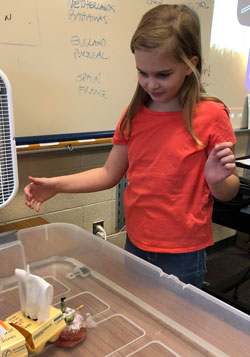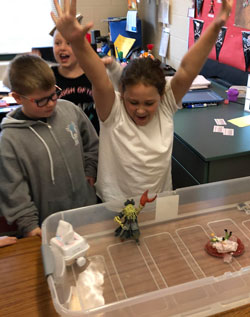Students in Tony Molnar’s STEM classes at Pine Island Elementary came across some rough waters in their classroom.
As part of the second year of using the Flite Test STEM curriculum in Comstock Park Public Schools, Molnar decided to use a pirate theme crafting ships for boat races, following the same format as paper airplane races they did the previous year.

One Man’s Trash
Using donated items like egg cartons, notecards and hot glue, more than 80 student groups among 15 classes constructed their boats and competed for the vessels to win in races.
Students learned what kind of sail was best for speed, what shape floated and what materials were best suited for the competition by working as a team and testing out boats before the race.
The actual race took place in plastic tubs filled with water and obstacles that the boats had to navigate around. A fan behind the tub propelled the boats forward in most cases.
“My favorite part was building the ship. We got to use a bunch of things that I didn’t know could make a ship,” said Dallas Klein, a third-grade student in teacher Kristina Altman’s class. “And pirates are fun.”

Making mistakes is also part of the fun.
“We definitely messed up a couple of times, it was really funny,” he said. “We went to put the boat in the water and ‘bam’ it falls right over.”
Third-grader Skylar Dewild’s favorite part was devising a plan for her boat and considering how it would best race. On the course for the homemade boats, Molnar often places obstacles, like marooned pirates and evil creatures, which students have to avoid.
“It’s so much fun because we get to use strategy and see what does and does not work. Sometimes it’s crazy,” Skylar said. “This class goes by so quickly.”

Making Learning Fun
Racing pirate ships touches on several components of the STEM curriculum, Molnar said.
“If you look at the standards, the project covers the main goals and reaches into many aspects of science and speed,” he said. “The main thing is that kids are communicating with each other to get a task done.”
Each student was able to name their ship and create a flag to fly during competition.
“They get ownership of a project which is really cool for them, to have something they created and get to use themselves,” Molnar said. “We’re not going to the computer lab all hour here which always get a groan out of people in the beginning. I tell them that they can look at the screens outside of our class, In here, we’re working with our hands.:

Funding Fun
Each year, Molnar’s program receives a $250 grant for supplies, most of which goes to purchasing building materials for the next year.
“I do get some money for projects, but creativity comes before money in making things go a long way,” he said. “It’s all about making sure that the kids are having fun and taking something away at the end of the project.”
In addition to hands-on building projects, Molnar’s class has a strong emphasis on digital elements utilizing Ipads, a green screen and some excited kids.
“I try to put up videos of every project we do on my website as well as sites kids can go to keep the learning going at home,” he said. “This class is my chance to make this kind of learning fun. It’s such a great experience for me and for the kids.”
CONNECT









